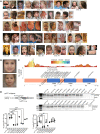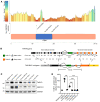Spliceosome malfunction causes neurodevelopmental disorders with overlapping features
- PMID: 37962958
- PMCID: PMC10760965
- DOI: 10.1172/JCI171235
Spliceosome malfunction causes neurodevelopmental disorders with overlapping features
Abstract
Pre-mRNA splicing is a highly coordinated process. While its dysregulation has been linked to neurological deficits, our understanding of the underlying molecular and cellular mechanisms remains limited. We implicated pathogenic variants in U2AF2 and PRPF19, encoding spliceosome subunits in neurodevelopmental disorders (NDDs), by identifying 46 unrelated individuals with 23 de novo U2AF2 missense variants (including 7 recurrent variants in 30 individuals) and 6 individuals with de novo PRPF19 variants. Eight U2AF2 variants dysregulated splicing of a model substrate. Neuritogenesis was reduced in human neurons differentiated from human pluripotent stem cells carrying two U2AF2 hyper-recurrent variants. Neural loss of function (LoF) of the Drosophila orthologs U2af50 and Prp19 led to lethality, abnormal mushroom body (MB) patterning, and social deficits, which were differentially rescued by wild-type and mutant U2AF2 or PRPF19. Transcriptome profiling revealed splicing substrates or effectors (including Rbfox1, a third splicing factor), which rescued MB defects in U2af50-deficient flies. Upon reanalysis of negative clinical exomes followed by data sharing, we further identified 6 patients with NDD who carried RBFOX1 missense variants which, by in vitro testing, showed LoF. Our study implicates 3 splicing factors as NDD-causative genes and establishes a genetic network with hierarchy underlying human brain development and function.
Keywords: Development; Genetic diseases; Genetics; Neurodevelopment; iPS cells.
Figures





References
Publication types
MeSH terms
Substances
Grants and funding
LinkOut - more resources
Full Text Sources
Molecular Biology Databases
Miscellaneous

